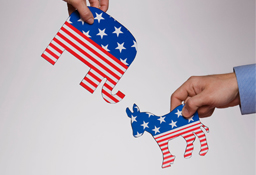Why a donkey? Why an elephant?
Why did the two major political parties choose a donkey and an elephant as their party symbols? Actually . . . they didn’t. At least not intentionally. There are several versions of the story explaining how these animals became associated with the Democratic Party and the Republican Party.
Some say that Democrat Andrew Jackson first used a donkey as a symbol for himself on his campaign posters during his 1828 presidential campaign. His opponents had called him stubborn for insisting that the government should be run by the people.
A famous cartoonist, Thomas Nast, also popularized the donkey as a symbol for the Democrats in an 1874 political cartoon for Harper’s Weekly magazine. When Republican Ulysses S. Grant was considering a campaign for a third presidential term, Democrats called it “Caesarism,” after the Roman Emperor Julius Caesar. They said Grant was being undemocratic. To counter what he considered the Democrats’ scare tactics, Nast drew a donkey disguised as a lion that frightened other animals, including an elephant. In his cartoon, entitled “Third Term Panic,” the elephant was a symbol for the Republican voters who fell into the Democrats’ trap and stopped supporting Grant.


